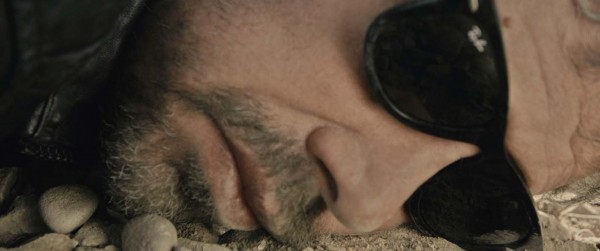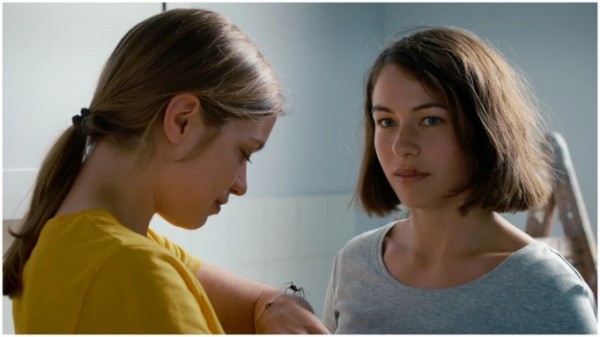-
AHED'S KNEE (Nadav Lapid 2021)
NADAV LAPID: AHED'S KNEE (2021)

AVSHALOM POLLAK IN AHED'S KNEE
Lapid grows more personal and more angry in the second of two taunts directed at his native Israel
For his last movie, Synonyms, the Israeli filmmaker Nadav Lapid found Tom Mercier, a startlingly confident and impressive-looking young, untried actor accomplished in dance and judo. For his new one, called, rather deceptively, Ahed's Knee, he had no one but himself, or, that is, a stand-in for himself in the person of a director called "Y" (Avshalom Pollak). He doesn't go to Paris; he stays in Israel, where he is initially seen at work on a video installation about a teenaged Palestinian girl jailed and maimed (with a smashed knee) for slapping an Israeli soldier - a film he can't make.
Pollak, with his trim frame, wiry gray hair, and far-off eyes, has his face literally in our faces throughout. The same cinematographer, Shai Goldman, who pursued Mercier rough-shod around Paris follows Pollak out into the bled, where "Y" comes to present one of his films at a library. Pollak is almost as photogenic as he is intense. He hasn't the talents or the physicality of Mercier, but his anger, putatively channeling more directly that of Lapid himself, carries him through. This movie is about this anger and that is its motive force and power.
In Synonymes, Mercier 's character, Yoav, sneaks somewhat inexplicably into Paris to get away from Israel, which he despises, and adopt France as his country and French as his language. Lapid has explained that he tried on such a pose himself once briefly (he went to Paris after studying philosophy at Tel Aviv University and then performing military service). His reasons were his own for adopting Paris and French. Though the film doesn't make this explicit, such a transformation is more logical for Mercier, who, as his name shows, actually is French on his father's side - connected with forebears who fought bravely for France in World War I.
These trappings are dropped in the much simpler and briefer traffic of the screen in Ahed's Knee. There's just the desert, a lake, pebbles, and a young woman library official from the region, Yahalom David (Nur Fibak) sent by the all-powerful Ministry of Culture to greet "Y" and, more importantly get him to toe the line - sign a document that will restrict the range of topics he can discuss during his appearance with the film. This enrages "Y" and is the pretext for a cloud of condemnations hurled down on the government and people of Israel, both of whom he sees as in a continual progress of self- and externally-exposed dumbing-down. Since that was only the starting point of Synonyms, this might seem a considerably more provocative film from the Israeli point of view.
But is it? The credits that come with the movie indicate government approval. And though the rant is far lengthier, still the most grievous faults of the country, its longtime mistreatment of the Palestinian people and seizure of their lands and property, its total economic dependence on the US, are never mentioned here. What is mentioned is "Y's" mother suffering from cancer, a reference to the filmmaker's own material collaborator and her own sufferings.
Despite the strong presence of the desert, handsomely photographed by dp Goldman, and the brief appearance of a crowd from the film showing, hostile when "Y's" tricky exposure of government repression threatens also the job of home-girl Yahalom, Ahed's Knee has a strong theatrical quality. It never achieves anything as cinematic and visually memorable as the opening sequence of Yoav's bath and naked wanderings in the Haussmannian apartment complex in Synonyms. It leaves us with a somewhat blurry cri de coeur. And yet, its anger's nonetheless real, and its form very bold. One can sympathize with Make D'Angelo's notes: "AHED’S KNEE is divisive; as someone who found Lapid’s previous films overbearing, I paradoxically loved this one, in which he cranks his formal aggression to 11."
Seeing Ahed's Knee on the big screen leaves one shocked and numbed by its angry shouting, accusations, and loud pop music, but the brief time frame and limited character development provide less to remember than Synonyms. It led me to rewatch that to again savor Mercier's sexy theatricality, and again see how the glow of the opening scenes is strong enough to hold together the relatively fluffy later sequences. Mercier decided - unlike the young post-army Lapid - to remain in France, and his career has continued. It's included a strange French sci-fi miniseries called "La Corde" (The Rope), a moody film of nocturnal Paris called Ma Nuit, and Luca Guadagnino's engaging, complex HBO series, "We Are Who We Are," set in Chioggia, Italy, perhaps the most richly specific depiction ever of life at a US military base abroad. In "We Are Who We Are," Mercier plays Jonathan Kritchevsky, a transplanted Israeli who has become a US Army NCO under the authority of Chloe Sevigny's lesbian unit commander who forms a brief, teasingly sexual connection with her son Fraser (Jack Dylan Grazer), one of the two self-questioning 14-year-olds who are the show's co-protagonists.
Ahed's Knee (Hebrew: הַבֶּרֶךְ, romanized: Ha'berech, "The Knee"), 109 mins., debuted n Competition at Cannes Jul. 7, 2021, sharing the Jury Prize with Apichatpong Weerasethakul's Memoria. Also shown at Warsaw, Karlovy Vary, Toronto, the NYFF, Yerevan (as opening film), Busan, London, Gent, Montreal, and 9 other festivals. It opened theatrically in France Sept. 15, 2021, in the US Mar. 18, 2021. AlloCiné press rating 3.5 (70%), Metacritic rating 76%. (Now up to 79%...80%...)
-
THE GIRL AND THE SPIDER/DAS MÄDCHEN UND DIE SPINNE (Ramon, Silvan Zürcher 2021)
RAMON ZÜRCHER, SILVAN ZÜRCHER: THE GIRL AND THE SPIDER/DAS MÄDCHEN UND DIE SPINNE (2021)

HENRIETTE CONFURIIUS, LILIANE AMUAT IN THE GIRL AND THE SPIDER
Looks and portents
The Zürcher twins, Ramon and Silvan, working in tandem now as joint directors, eight years later offer with The Girl and the Spider what they declare to be "the second installment of a loose trilogy about human togetherness." The first part (where only Ramon was listed as the director) was 2013's The Strange Little Cat, and the third part will be The Sparrow in the Chimney,, which they will shoot this summer. The Girl and the Spider mostly transpires in the confines of an apartment, then another, and focuses on Lisa (Liliane Amuat), who is moving out of the flat she has shared with Mara to one of her own, leaving Mara (Henriette Confurius), who "sees herself confronted with a rollercoast of emotions." Watching the Zürchers describing this, finishing each other's sentences in true twin fashion, one can't help wondering if their interest in "human togetherness" (whatever exactly they means by that) or a "rollercoast [sic] of emotions" might be rather different from the usual ones. Or whether maybe the are sometimes more interested in moving (rather attractive) people around in confined spaces. And they are clearly not interested in delving more than very minimally into developed stories.
Many cinephiles and film festival followers nonetheless were intrigued and delighted by The Strange Little Cat, because what the Zürcher twins clearly were good at was a certain kind of deft, sometimes teasing, manipulation of small physical details within confined inhabited spaces, adults, children, animals - and now, even a moderately large arachnid, using precise cinematic means. This time, with The Girl and the Spider, they have taken a few timid steps further toward the human and the emotional, toward desire and relationships. They expand their run-time from 72 minutes to 98, and focus not just on one day in one apartment, like last time, but on two days in two apartments. It's a veritable epic! And also, as Peter Debruge puts it in his Berlinale review in Variety, they shift their focus (I would say) tentatively more toward the human, concentrating this time less on the "logistics" of Lisa's move and more on the "micro-dramas it creates."
Above all there are a lot more meaningful glances and hints of imminent or wished-for relationships or, since Lisa's departure may be a kind of break-up - vanishing ones. Looking and watching are what people are doing all through The Girl and the Spider. And those looks are fraught and fascinating. But the "micro-dramas" remain that. They never quite lead far from hints and portents or into connected narratives.
There are more defined relationships, perhaps. The new apartment is being remodeled, and there are people working on that. Lisa’s mother, Astrid (Ursina Lardi), and the contractors try to make fixes to the new apartment; Astrid and the older head contractor (André M. Hennicke) seem to want another connection. HIs son Jan (Flurin Giger) tries to chat with Mara and shows up later at a party hoping to sleep with her. Mara, who seems discontented with developments, causes minor havoc. She bothers a dog on the other side of a bathroom door, accidentally gouges a new countertop, and stabs a Styrofoam cup full of wine with a pencil and causes a big mess. Mysteriously, a downstairs neighbor leaves her crying infant to kiss Mara on the cheek and say she's sorry its not she who's moving in because she's sure they would "have fun together." A cat turns out to have been kidnapped by another neighbor at the old apartment. And then there is the herpes, which shifts from one woman's lip to the other's.
If you like speculating about these events and about the many bat-squeaks of sexuality exchanged between various men and women, this new Zürcher film, which definitely makes tentative jumps toward the human from the earlier one, will fascinate you. But be warned that the twins are great teases. Nothing goes further than a hint before the scene deftly shifts to a new incident, a new pair of people on screen. They are attractive people, particularly Liliane Amuat as Lisa, who has luminous blue eyes, and the "music-box whirl of Eugen Doga’s 'Gramophone waltz" (Debruge again), as well as the dance party that comes as a kind of climax, make events in The Girl and the Spider feel like a harmonious cinematic mini-spectacle. "The Zürchers succeed in piquing our curiosity, which is all one really needs to sustain a film," Debruge writes. Not for everyone. I watched with pleasure, yet was left feeling frustrated. But I can't say I didn't want to watch it again.
The Girl and the Spider/Das Mädchen und die Spinne, 98 min., opened in German-speaking Switzerland May 13, 2021 and showed at 36 festivals between May 2021 and Feb. 2022, including the Berlinale, Toronto, the NYFF, and the AFI. It opens Apr. 8, 2022 at Metrograph and runs there for one week.
 Posting Permissions
Posting Permissions
- You may not post new threads
- You may not post replies
- You may not post attachments
- You may not edit your posts
-
Forum Rules





 Reply With Quote
Reply With Quote

Bookmarks